Mazda Reveals Next-Generation ‘SKYACTIV’ Technologies
HIROSHIMA, Japan—Mazda Motor Corporation today announced the launch of its SKYACTIV next-generation technologies — including engines, transmissions, vehicle bodies and chassis — that will begin appearing in Mazda products from 2011. The Mazda Demio (known overseas as the Mazda2) will be the first model to feature SKYACTIV technology and will go on sale in Japan in the first half of 2011. It will be powered by the SKYACTIV-G, Mazda’s next-generation direct injection gasoline engine that achieves significantly improved fuel efficiency thanks to a high compression ratio of 14.0:1*. The Mazda Demio SKYACTIV-G will achieve fuel economy of 30 kilometers per liter† without any assistance from an electric motor.
SKYACTIV is a blanket term for Mazda’s innovative next-generation technologies that are being developed under the company’s long-term vision for technology development, Sustainable Zoom-Zoom. The SKYACTIV name is intended to reflect Mazda’s desire to provide driving pleasure as well as outstanding environmental and safety performance in its vehicles. To achieve this goal, Mazda has implemented an internal Building Block Strategy to be completed by 2015. This ambitious strategy involves the comprehensive optimization of Mazda’s base technologies, which determine the core performance of its vehicles, and the progressive introduction of electric devices such as regenerative braking and a hybrid system. All the technologies that are developed based on the Building Block Strategy will fall under the SKYACTIV umbrella.
Takashi Yamanouchi, Mazda’s Representative Director, Chairman of the Board, President and CEO, said, “Mazda is renewing its entire powertrain and platform lineup at the same time as revolutionizing every manufacturing process from R&D through to mass production. There have been no compromises in addressing conflicting goals. Instead, we have implemented a ‘breakthrough’ approach to technical innovation in all areas that has produced incredible, unexpected results. One of our success stories is the next-generation engine that will first appear in the Mazda Demio which goes on sale in the first half of 2011. Achieving an outstanding 30 kilometers per liter fuel economy, the SKYACTIV Demio will be a fun-to-drive fuel sipper that will satisfy anyone’s desire for driving pleasure. And there will be many more exciting new products coming to the Mazda lineup in the years ahead.”
* Compression ratio and some engine technologies vary depending on fuel type and vehicle specifications
† Measured according to Japan’s 10-15 mode test cycle
Overview of the SKYACTIV technologies
1. SKYACTIV-G
A next-generation highly-efficient direct-injection gasoline engine that achieves the world’s highest gasoline engine compression ratio of 14.0:1 with no abnormal combustion (knocking)
The world’s first gasoline engine for mass production vehicles to achieve a high compression ratio of 14.0:1
Significantly improved engine efficiency thanks to the high compression combustion, resulting in 15 percent increases in fuel efficiency and torque
Improved everyday driving thanks to increased torque at low- to mid-engine speeds
A 4-2-1 exhaust system, cavity pistons, multihole injectors and other innovations enable the high compression ratio
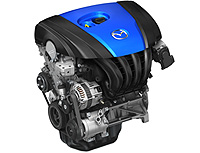
SKYACTIV-G
2. SKYACTIV-D
A next-generation clean diesel engine that will meet global emissions regulations without expensive NOx aftertreatments — urea selective catalytic reduction (SCR) or a Lean NOx Trap (LNT) — thanks to the world’s lowest diesel engine compression ratio of 14.0:1
20 percent better fuel efficiency thanks to the low compression ratio of 14.0:1
A new two-stage turbocharger realizes smooth and linear response from low to high engine speeds, and greatly increases low- and high-end torque (up to the 5,200 rpm rev limit)
Complies with global emissions regulations (Euro6 in Europe, Tier2Bin5 in North America, and the Post New Long-Term Regulations in Japan), without expensive NOx aftertreatment
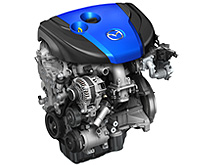
SKYACTIV-D
3. SKYACTIV-Drive
A next-generation highly efficient automatic transmission that achieves excellent torque transfer efficiency through a wider lock-up range and features the best attributes of all transmission types
Combines all the advantages of conventional automatic transmissions, continuously variable transmissions, and dual clutch transmissions
A dramatically widened lock-up range improves torque transfer efficiency and realizes a direct driving feel that is equivalent to a manual transmission
A 4-to-7 percent improvement in fuel economy compared to the current transmission

SKYACTIV-Drive
4. SKYACTIV-MT
A light and compact next-generation manual transmission with crisp and light shift feel like that of a sports car, optimized for a front-engined front-wheel-drive layout
Short stroke and light shift feel
Significantly reduced size and weight due to a revised structure
More efficient vehicle packaging thanks to its compact size
Improved fuel economy due to reduced internal friction
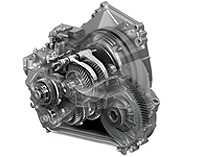
SKYACTIV-MT
5. SKYACTIV-Body
A next-generation lightweight, highly-rigid body with outstanding crash safety performance and high rigidity for greater driving pleasure
High rigidity and lightness (8 percent lighter, 30 percent more rigid)
Outstanding crash safety performance and lightness
A “straight structure” in which each part of the frame is configured to be as straight as possible. Additionally, a “continuous framework” approach was adopted in which each section functions in a coordinated manner with the other connecting sections
Reduced weight through optimized bonding methods and expanded use of high-tensile steel
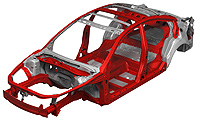
SKYACTIV-Body
6. SKYACTIV-Chassis
A next-generation high-performance lightweight chassis that balances precise handling with a comfortable ride feel to realize driving pleasure
Newly developed front strut and rear multilink suspension ensures high rigidity and lightness (The entire chassis is 14 percent lighter than the previous version.)
Mid-speed agility and high-speed stability — enhanced ride quality at all speeds achieved through a revision of the functional allocation of all the suspension and steering components
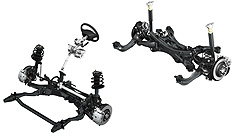
SKYACTIV-Chassis
